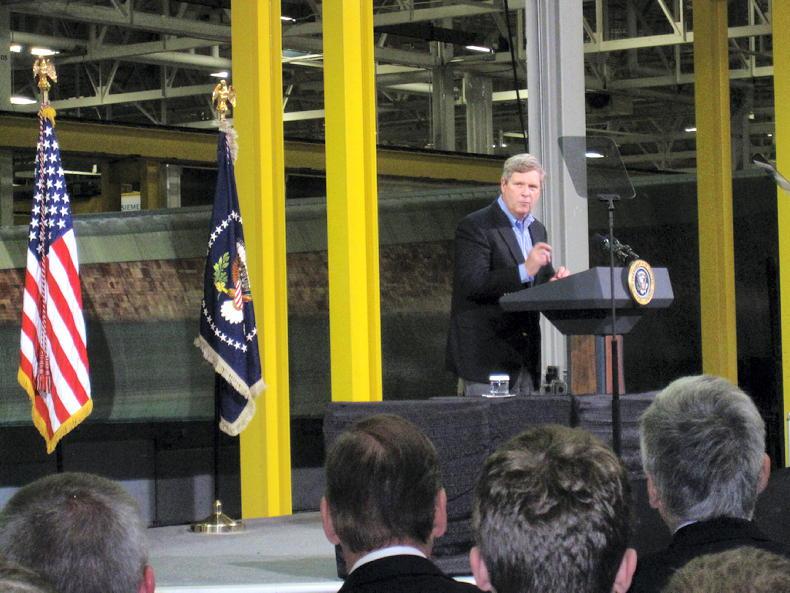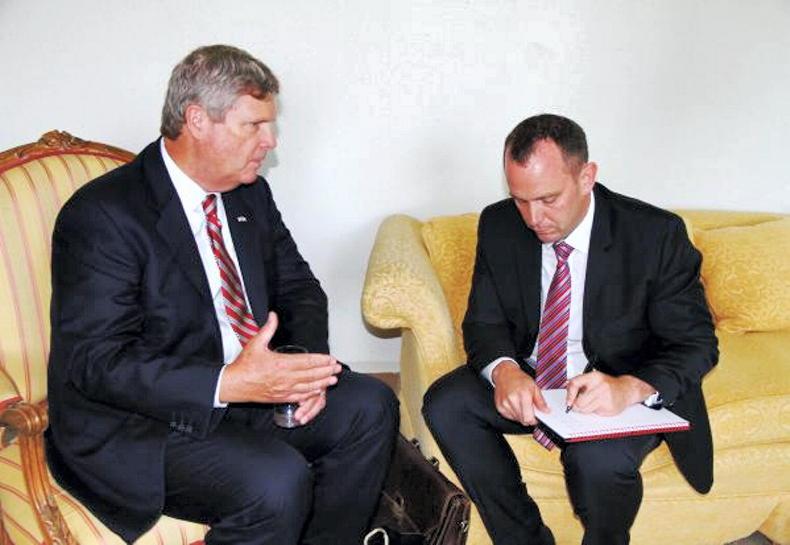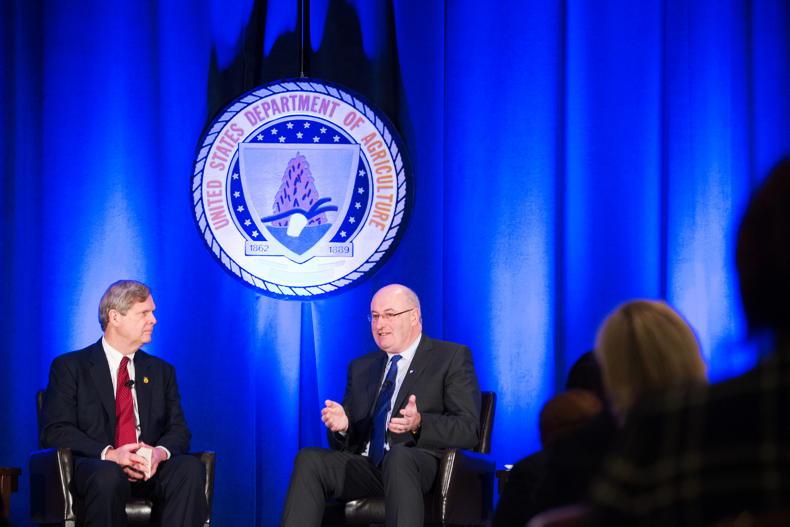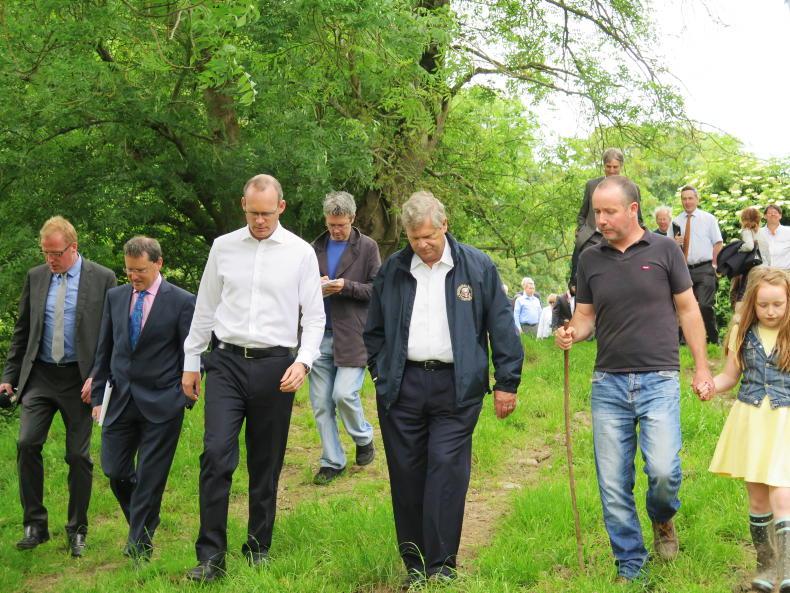The following interview with Tom Vilsack appeared in the Irish Farmers Journal in June 2014.
Tom Vilsack is extremely articulate, with the ability to give a coherent presentation without the need for speaking notes.
The US secretary for agriculture has an excellent understanding of his brief, helped by the fact that he farms 500 acres in the state of Iowa and is clearly a very distinguished negotiator.
These are all characteristics that will undoubtedly see the US adopt a strong position on agriculture when negotiating the Transatlantic Trade and Investment Partnership (TTIP) with its EU counterparts.
In discussions last Thursday, the agenda for the stopover in Ireland quickly became clear.
As part of the TTIP, secretary Vilsack is determined to secure increased access to the EU market for US beef.
He is acutely aware that Ireland and France, the only other member state to receive individual attention, will be the most vocal opponents to any concessions.
Commitment
The commitment given during his visit that a “deal was done” on reopening the US market to Irish beef was no doubt strategic. However, in our discussion, he refused to be drawn on when the market would actually open and the volumes of Irish beef that could potentially enter the US.
“Irish beef should be competitive along the east coast,” he said, adding that “marketing will be key”.
We should watch developments closely over the coming months regarding how the USDA facilitates the re-entry of Irish beef.
Will we see the USDA impose “product inspection fees” on Irish beef entering the US - a strategy used in the past to impose an artificial tariff and reduce market competitiveness?

We should be in no doubt that the Irish visit was part of a charm offensive aimed at helping to alleviate fears that opening the EU market to US beef would drive down prices.
Having visited an excellent Irish beef and dairy farm earlier in the day, secretary Vilsack was at pains to dispel the view that US farming was large-scale.
“If I closed my eyes, it was like being on many of the farms I visited in the US,” he said.
Secretary Vilsack argues that US production is not dependant on large-scale factory farming, but smaller family farms typical of what he saw during his short visit to Ireland.
The claims come despite USDA figures showing almost 35% of all cattle operations run at least 1,000 head. The figure profiles all cattle operations in the US, as reported by the USDA.
Meanwhile, almost 55% of beef cow herds (sucklers) have over 100 cows, with progeny traditionally finished in large-scale feedlots.

Tom Vilsack and Justin McCarthy.
In Texas, the heartland of US beef production, the average feedlot has the capacity to finish 20,500 head per annum.
Portraying an image of a US production model based on small and environmentally friendly family farms will undoubtedly form a strategic part of US negotiations – aimed at helping to alleviate any fears that the large-scale factory farms will flood the EU market.

Tom Vilsack with Phil Hogan.
On this theme, secretary Vilsack argues that a growing global market portfolio for US beef and the fact that the capacity of the sector is at its lowest since 1952 means that Irish farmers should have no concerns that US product will flood into the EU.
“Globally, there are more customers than food,” he said, adding that “there are opportunities for Ireland and the US”.
Defence
Secretary Vilsack is strong in his defence of the US beef production system being heavily dependent on the use of growth hormones, rejecting any notion that it should be a factor in the negotiation process.
He said: “Whatever decision is made must be based on science.”
When challenged as to whether or not he would be comfortable with US beef labelled as hormone-treated, he replied “the market should be open unless there is a scientific risk” – a clear reference to the US argument that there is no scientific evidence to support the EU decision to ban growth hormones.
Despite Vilsack’s assertions, it is clear that hormones and bio-tech will be a crunch issue in the negotiations around agriculture.
The topic is likely to have already featured heavily in discussions with [then] Minister for Agriculture Simon Coveney.
Untenable
There is no obvious solution for either side. For the EU, it would be untenable for politicians to allow hormone-treated beef enter the EU from the US, while at the same time enforcing a prison sentence on any EU farmer adopting the production enhancing technology. Meanwhile, for the US to accept that any beef entering the EU would have to be hormone-free immediately reopens the debate around the use of hormones in domestic production.
This is a debate the US does not want to have.
With the cocktail of growth hormones used on US feedlots delivering an efficiency gain equivalent to €1/kg deadweight, the profitability of the sector would be wiped out if their use was even curtailed in any way.
US feedlots are dependent on the increase in feed conversion, improvement in killout and carcase conformation and lower feed costs delivered from using hormones.
Science-based argument
The science-based argument is also likely to feature heavily in the bio-tech debate.
While development of GM technology has been stifled in the EU, we have seen an explosion in its adoption across the US.
It is estimated that, in 2013, 85% of corn, 91% of soybeans and 88% of cotton produced in the US were from GM plants.
Again, identifying an area of middle ground will be difficult, if not impossible.
With no obvious compromises available to either side, would it not make sense to exclude agriculture and, in particular, beef from TTIP negotiations?
After all, the US removed its heavily protected sugar market from the table when negotiating a trade deal with the Australians? Not according to Vilsack.

Tom Vilsack on the beef farm of Stephen Morrison in Kill, Co Kildare, with Simon Coveney.
He warned that without a strong agricultural title, it will be difficult to get the political votes in Congress necessary to get the bill passed.
He conceded that there are several levels a trade agreement needs to go through before concluding.
“People want answers before negotiations start,” he said, highlighting that there is always a void between talks and the time taken to reach a conclusion.
“Opponents to free trade fill this void,” he warned.
Secretary Vilsack refused to be drawn on the specifics of food security and the need for regions to protect domestic production.
Despite being a strong proponent of the US working towards improving energy security through various policy reforms, he did not accept the argument that the EU should work to protect its domestic agricultural production base.
He countered the argument with the view that forming a strategic partnership between the EU and US would improve food security by driving innovation, exploiting opportunities and growing markets.
Trade barriers
Of course, the true measure of this belief will be in the willingness of the US to remove trade barriers (both official and unofficial).
Will this “strategic” alliance see the US open the banking sector, allow EU businesses access to the government tendering process and, most importantly for Ireland, allow increased access for dairy products with reform of packing regulations?
Regarding the outlook for dairying, secretary Vilsack is confident that a strong global market will continue to drive demand.
“There is an enormous opportunity; our dairy industry struggled in 2009 and 2010 but it is stronger today,” he said.
Geographic indicators (GI) are a major issue for the US, specifically in the case of the dairy sector.
Market
Secretary Vilsack accepted that the US needed to understand how GIs work and accepted that ways must be found to protect value-added status without restricting the market.
He specifically highlighted the challenges around feta cheese, which in the EU has protected designation of origin (PDO) status, limiting the name 'feta' within the EU to brined cheese made exclusively of sheep and goats’ milk.
In contrast, the leading brand of 'feta' in the US is a product produced in north central Wisconsin from cow’s milk.
Perhaps the feta scenario gives us some insight into just how detailed negotiations on agriculture are likely to be.
Add to this the need to find a politically acceptable solution to the highly emotive issues of GM technology and growth hormones, and the challenges that lie ahead are clear.
Nevertheless, secretary Vilsack is adamant that agriculture must remain on the table throughout the TTIP negotiations.
He is robust in his defence of the production practices adopted within US agriculture.
However, as a seasoned negotiator, he is aware that political compromises will be required on both sides, if he is to keep agriculture in the frame.
EU farmers will be watching closely as to how far Brussels is prepared to compromise on standards.
Age: 70Married to Christie Bell, American literary advocate and politician, with two sons Jess and Doug, who both studied law.Holds a Juris Doctor (graduate degree in law) from Albany Law School.Vilsack served as the 40th Governor of Iowa from 1999 to 2007.United States Secretary of Agriculture from 2009 to 2017.Member of the Democratic Party.Ran for president of the United States in the 2008 election but pulled out in February 2007 citing monetary constraints.Quotable quote: “I don’t care what anybody says: nothing is better than a tomato you grow. There’s something about it that’s different than a tomato you can buy. It’s a great thing.”
The following interview with Tom Vilsack appeared in the Irish Farmers Journal in June 2014.
Tom Vilsack is extremely articulate, with the ability to give a coherent presentation without the need for speaking notes.
The US secretary for agriculture has an excellent understanding of his brief, helped by the fact that he farms 500 acres in the state of Iowa and is clearly a very distinguished negotiator.
These are all characteristics that will undoubtedly see the US adopt a strong position on agriculture when negotiating the Transatlantic Trade and Investment Partnership (TTIP) with its EU counterparts.
In discussions last Thursday, the agenda for the stopover in Ireland quickly became clear.
As part of the TTIP, secretary Vilsack is determined to secure increased access to the EU market for US beef.
He is acutely aware that Ireland and France, the only other member state to receive individual attention, will be the most vocal opponents to any concessions.
Commitment
The commitment given during his visit that a “deal was done” on reopening the US market to Irish beef was no doubt strategic. However, in our discussion, he refused to be drawn on when the market would actually open and the volumes of Irish beef that could potentially enter the US.
“Irish beef should be competitive along the east coast,” he said, adding that “marketing will be key”.
We should watch developments closely over the coming months regarding how the USDA facilitates the re-entry of Irish beef.
Will we see the USDA impose “product inspection fees” on Irish beef entering the US - a strategy used in the past to impose an artificial tariff and reduce market competitiveness?

We should be in no doubt that the Irish visit was part of a charm offensive aimed at helping to alleviate fears that opening the EU market to US beef would drive down prices.
Having visited an excellent Irish beef and dairy farm earlier in the day, secretary Vilsack was at pains to dispel the view that US farming was large-scale.
“If I closed my eyes, it was like being on many of the farms I visited in the US,” he said.
Secretary Vilsack argues that US production is not dependant on large-scale factory farming, but smaller family farms typical of what he saw during his short visit to Ireland.
The claims come despite USDA figures showing almost 35% of all cattle operations run at least 1,000 head. The figure profiles all cattle operations in the US, as reported by the USDA.
Meanwhile, almost 55% of beef cow herds (sucklers) have over 100 cows, with progeny traditionally finished in large-scale feedlots.

Tom Vilsack and Justin McCarthy.
In Texas, the heartland of US beef production, the average feedlot has the capacity to finish 20,500 head per annum.
Portraying an image of a US production model based on small and environmentally friendly family farms will undoubtedly form a strategic part of US negotiations – aimed at helping to alleviate any fears that the large-scale factory farms will flood the EU market.

Tom Vilsack with Phil Hogan.
On this theme, secretary Vilsack argues that a growing global market portfolio for US beef and the fact that the capacity of the sector is at its lowest since 1952 means that Irish farmers should have no concerns that US product will flood into the EU.
“Globally, there are more customers than food,” he said, adding that “there are opportunities for Ireland and the US”.
Defence
Secretary Vilsack is strong in his defence of the US beef production system being heavily dependent on the use of growth hormones, rejecting any notion that it should be a factor in the negotiation process.
He said: “Whatever decision is made must be based on science.”
When challenged as to whether or not he would be comfortable with US beef labelled as hormone-treated, he replied “the market should be open unless there is a scientific risk” – a clear reference to the US argument that there is no scientific evidence to support the EU decision to ban growth hormones.
Despite Vilsack’s assertions, it is clear that hormones and bio-tech will be a crunch issue in the negotiations around agriculture.
The topic is likely to have already featured heavily in discussions with [then] Minister for Agriculture Simon Coveney.
Untenable
There is no obvious solution for either side. For the EU, it would be untenable for politicians to allow hormone-treated beef enter the EU from the US, while at the same time enforcing a prison sentence on any EU farmer adopting the production enhancing technology. Meanwhile, for the US to accept that any beef entering the EU would have to be hormone-free immediately reopens the debate around the use of hormones in domestic production.
This is a debate the US does not want to have.
With the cocktail of growth hormones used on US feedlots delivering an efficiency gain equivalent to €1/kg deadweight, the profitability of the sector would be wiped out if their use was even curtailed in any way.
US feedlots are dependent on the increase in feed conversion, improvement in killout and carcase conformation and lower feed costs delivered from using hormones.
Science-based argument
The science-based argument is also likely to feature heavily in the bio-tech debate.
While development of GM technology has been stifled in the EU, we have seen an explosion in its adoption across the US.
It is estimated that, in 2013, 85% of corn, 91% of soybeans and 88% of cotton produced in the US were from GM plants.
Again, identifying an area of middle ground will be difficult, if not impossible.
With no obvious compromises available to either side, would it not make sense to exclude agriculture and, in particular, beef from TTIP negotiations?
After all, the US removed its heavily protected sugar market from the table when negotiating a trade deal with the Australians? Not according to Vilsack.

Tom Vilsack on the beef farm of Stephen Morrison in Kill, Co Kildare, with Simon Coveney.
He warned that without a strong agricultural title, it will be difficult to get the political votes in Congress necessary to get the bill passed.
He conceded that there are several levels a trade agreement needs to go through before concluding.
“People want answers before negotiations start,” he said, highlighting that there is always a void between talks and the time taken to reach a conclusion.
“Opponents to free trade fill this void,” he warned.
Secretary Vilsack refused to be drawn on the specifics of food security and the need for regions to protect domestic production.
Despite being a strong proponent of the US working towards improving energy security through various policy reforms, he did not accept the argument that the EU should work to protect its domestic agricultural production base.
He countered the argument with the view that forming a strategic partnership between the EU and US would improve food security by driving innovation, exploiting opportunities and growing markets.
Trade barriers
Of course, the true measure of this belief will be in the willingness of the US to remove trade barriers (both official and unofficial).
Will this “strategic” alliance see the US open the banking sector, allow EU businesses access to the government tendering process and, most importantly for Ireland, allow increased access for dairy products with reform of packing regulations?
Regarding the outlook for dairying, secretary Vilsack is confident that a strong global market will continue to drive demand.
“There is an enormous opportunity; our dairy industry struggled in 2009 and 2010 but it is stronger today,” he said.
Geographic indicators (GI) are a major issue for the US, specifically in the case of the dairy sector.
Market
Secretary Vilsack accepted that the US needed to understand how GIs work and accepted that ways must be found to protect value-added status without restricting the market.
He specifically highlighted the challenges around feta cheese, which in the EU has protected designation of origin (PDO) status, limiting the name 'feta' within the EU to brined cheese made exclusively of sheep and goats’ milk.
In contrast, the leading brand of 'feta' in the US is a product produced in north central Wisconsin from cow’s milk.
Perhaps the feta scenario gives us some insight into just how detailed negotiations on agriculture are likely to be.
Add to this the need to find a politically acceptable solution to the highly emotive issues of GM technology and growth hormones, and the challenges that lie ahead are clear.
Nevertheless, secretary Vilsack is adamant that agriculture must remain on the table throughout the TTIP negotiations.
He is robust in his defence of the production practices adopted within US agriculture.
However, as a seasoned negotiator, he is aware that political compromises will be required on both sides, if he is to keep agriculture in the frame.
EU farmers will be watching closely as to how far Brussels is prepared to compromise on standards.
Age: 70Married to Christie Bell, American literary advocate and politician, with two sons Jess and Doug, who both studied law.Holds a Juris Doctor (graduate degree in law) from Albany Law School.Vilsack served as the 40th Governor of Iowa from 1999 to 2007.United States Secretary of Agriculture from 2009 to 2017.Member of the Democratic Party.Ran for president of the United States in the 2008 election but pulled out in February 2007 citing monetary constraints.Quotable quote: “I don’t care what anybody says: nothing is better than a tomato you grow. There’s something about it that’s different than a tomato you can buy. It’s a great thing.”










 This is a subscriber-only article
This is a subscriber-only article










SHARING OPTIONS: